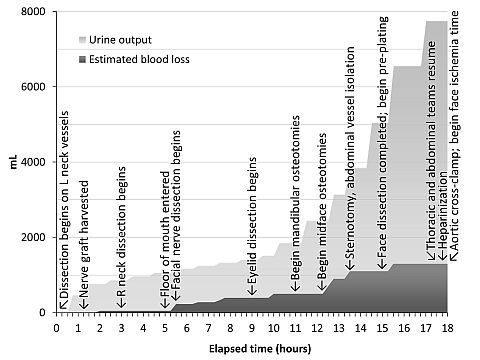Total Face and Multi-Organ Procurement from a Brain-Dead Donor: Institutional Experience and Proposed Algorithm
Department of Surgery, University of Maryland, Baltimore, MD
Division of Plastic Surgery, R Adams Cowley Shock Trauma Center, University of Maryland, Baltimore, MD
Division of Cardiac Surgery, University of Maryland, Baltimore, MD
Division of Transplantation, University of Maryland, Baltimore, MD
Meeting: 2013 American Transplant Congress
Abstract number: C1249
Purpose:
A full facial procurement should allow concurrent procurement of all solid organs and ensure their integrity. Procurement of facial vascularized composite allografts (VCA) challenges surgical teams with complex defects potentially requiring far greater time than solid organs, risking prolonged cold ischemia or solid organ damage. These concerns necessitate an algorithm to coordinate solid organ and face teams in context of the donor’s clinical status.
Methods:
A VCA including all facial skin, mimetic muscles, multiple sensory and motor nerve branches, anterior tongue, and maxillary and mandibular segments was procured from a brain dead donor. Solid organ recovery included heart, lungs, liver, kidneys, and pancreas. Bedside tracheostomy and facial mask impression were performed preoperative day 1.
Results:
Facial VCA dissection time was 12 hours, spaced over a 15 hour period to diminish ischemia while the recipient was being prepared (Figure). Solid organ dissection began at 13.5 hours, during the midfacial ostotomies, and recovery concluded immediately after facial explantation. Estimated blood loss was 1300 mL, requiring 5 units of pRBC and 2 units FFP. Facial, thoracic, and abdominal teams were able to work concurrently. MAP averaged 84±9 mm Hg, pH 7.40±0.03, and PaO2 206±28 mm Hg. All organs had good postoperative function.
Conclusions:
We propose an algorithm that allows “face first, concurrent completion” isolation of a complex facial VCA by planning multiple pathways to expedient recovery of vital organs in the event of donor instability. Preoperative, bedside tracheostomy and facial mask impression reduce operative time. Beginning the recipient operation first may reduce waiting time due to difficult recipient preparation caused by extensive scarring.

To cite this abstract in AMA style:
Brazio P, Bojovic B, Christy M, Garcia J, Brown E, Bartlett S, Barth R, Rodriguez E. Total Face and Multi-Organ Procurement from a Brain-Dead Donor: Institutional Experience and Proposed Algorithm [abstract]. Am J Transplant. 2013; 13 (suppl 5). https://atcmeetingabstracts.com/abstract/total-face-and-multi-organ-procurement-from-a-brain-dead-donor-institutional-experience-and-proposed-algorithm/. Accessed July 13, 2025.« Back to 2013 American Transplant Congress
